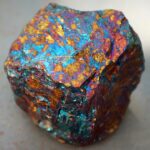Chromium, a chemical element that holds a prominent place in both industrial and biological contexts, possesses a unique atomic structure. At the heart of this structure lies the proton, a fundamental particle with crucial significance in defining an element’s identity. This article seeks to delve into the mysteries of chromium’s atomic composition, particularly focusing on the number of protons it harbors. By exploring its atomic structure, isotopes, and practical applications, we will uncover the fundamental question: how many protons does chromium have?

Chromium at a Glance: A Brief Introduction
Before we embark on our journey to unveil the number of protons in chromium, it’s essential to provide a concise overview of this element.
Chromium, with the atomic symbol Cr and atomic number 24, is a transition metal. It’s the 24th element in the periodic table, placing it between vanadium (V) and manganese (Mn). This metallic element exhibits fascinating properties under standard conditions: it appears as a hard silvery metal with a distinctive bluish tint. But what makes chromium truly remarkable is its atomic structure, which we’ll dissect in the following sections.
Chromium’s Atomic Structure: Electrons and Protons
To understand the number of protons in chromium, we must delve into its atomic structure, which is defined by the arrangement of electrons, protons, and neutrons.
- Electrons in Chromium: Chromium atoms contain 24 electrons. These electrons orbit the nucleus in specific energy levels or electron shells. The electron configuration of a chromium atom is 1s² 2s² 2p⁶ 3s² 3p⁶ 3d⁵ 4s¹. This arrangement reflects the distribution of electrons in different energy levels and orbitals, which plays a vital role in the element’s chemical behavior and reactivity.
- Protons in Chromium: The atomic number of chromium is 24, indicating the number of protons in the nucleus. Each proton carries a positive charge, and the total number of protons determines the element’s identity. Therefore, chromium unequivocally possesses 24 protons at its core.
- Neutrons in Chromium: Neutrons, the uncharged particles in an atom’s nucleus, contribute to the element’s mass. While the most abundant isotope of chromium has 28 neutrons, it’s important to note that there are several isotopes of chromium with varying neutron counts. Isotopes are versions of an element with the same number of protons but different numbers of neutrons. These isotopes have distinct properties and play important roles in scientific research and various industrial applications.
Isotopes of Chromium: A Matter of Neutrons
Chromium, like many elements, has multiple isotopes. Isotopes are characterized by differences in the number of neutrons while maintaining the same number of protons, which defines the element. Let’s explore some of the most prominent isotopes of chromium and their respective neutron counts.
- Chromium-50 (Cr-50): This isotope has 26 neutrons. While it is relatively rare, it has been used in nuclear physics experiments and the study of nuclear reactions.
- Chromium-51 (Cr-51): This isotope contains 27 neutrons. It is employed in radioisotope applications, such as radiolabeling in biology and medical research.
- Chromium-52 (Cr-52): With 28 neutrons, this is the most abundant isotope of chromium. It is the primary focus of this article, as it is the version of chromium commonly encountered in nature and its associated compounds.
- Chromium-53 (Cr-53): This isotope has 29 neutrons and is used in research involving nuclear reactions.
- Chromium-54 (Cr-54): With 30 neutrons, this isotope is another rare variant of chromium and is significant in nuclear physics.
It’s important to emphasize that despite the variation in neutron counts, all these isotopes share the same number of protons, which is 24, as dictated by chromium’s atomic number.
The Role of Protons in Chromium’s Identity
Protons, as fundamental particles, are the defining feature of an element. The number of protons in an atom’s nucleus is known as the atomic number, and it is unique to each element. In the case of chromium, with an atomic number of 24, there are precisely 24 protons. This proton count is what differentiates chromium from other elements and places it at the 24th position in the periodic table.
The atomic number also determines other critical properties of an element, such as its chemical reactivity and position in the periodic table. Understanding the proton count of an element is fundamental to discerning its identity and its interactions with other elements in chemical reactions.
Practical Applications of Chromium
Chromium’s unique properties and atomic structure make it an essential element with a wide range of practical applications. Let’s explore some of the key areas where chromium plays a crucial role:
- Stainless Steel Production: Chromium is a primary component of stainless steel, a corrosion-resistant alloy widely used in various industries, including construction, manufacturing, and the medical field. The addition of chromium to iron forms a passive oxide layer that prevents rust and corrosion.
- Chromium Plating: Chromium plating, often referred to as chrome plating, is a process that involves electroplating a layer of chromium onto various surfaces, such as automotive parts, kitchen appliances, and bathroom fixtures. This enhances the appearance and provides corrosion resistance.
- Alloying Agent: Chromium is used as an alloying agent in various alloys, such as nickel-chromium and iron-chromium alloys. These alloys find applications in high-temperature environments, such as jet engines and gas turbines.
- Chemical Compounds: Chromium is a component in a range of chemical compounds, including chromium picolinate and chromium chloride, which have applications in dietary supplements, catalysts, and industrial processes.
- Metallurgy: Chromium is utilized in the production of ferrous alloys, which are crucial for manufacturing a wide array of products, including machinery, tools, and transportation equipment.
- Aerospace Industry: Chromium-coated aerospace components offer protection against extreme conditions encountered in space and high-altitude flight.
- Biological Significance: In biology, chromium plays a role as an essential trace element, although the specific functions and requirements for chromium in living organisms are not yet fully understood.
These practical applications of chromium highlight the element’s versatility and importance in various fields, making it an integral part of modern industry and technology.
Conclusion
Chromium, with its atomic number of 24, unequivocally possesses 24 protons at its core. The atomic number is the defining characteristic of an element, and it determines its unique identity and chemical properties. While chromium may have multiple isotopes with varying neutron counts, the number of protons remains consistent, and this proton count defines chromium’s position in the periodic table and its role in various practical applications.
The significance of chromium extends beyond its proton count, as it is an essential element in modern industry, metallurgy, and technology. From stainless steel to aerospace components, chromium’s distinctive properties and versatility make it a crucial player in the world of materials science and engineering.
In closing, understanding the atomic structure of chromium, including the number of protons, offers insights into the elemental nature of matter and underscores the importance of basic atomic theory in our quest to comprehend the universe at its most fundamental level. Whether you encounter chromium in the form of stainless steel, chrome-plated finishes, or chemical compounds, its identity is rooted in the number of protons within its nucleus, an enduring and defining feature of this remarkable element.





